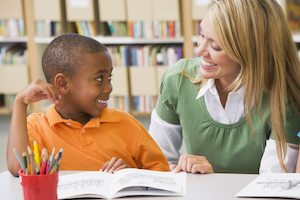How to Nurture Empathic Joy in Your Classroom
By Amy L. Eva
According to a new study, students perform better when teachers share in their joy.


According to a new study, students perform better when teachers share in their joy.
A new teacher I know recently shared the reason he decided to become an educator: “Cheesy maybe, but I became intrigued by teaching because of smiles. When a student I am working with smiles, the feeling I get is indescribable.”
My friend is describing “empathic joy”— the experience of sharing and understanding positive emotions. When our students feel happy, we feel happy. When our students celebrate a success, we celebrate with them. Empathic joy delights in the good everyone can share. And in the classroom, empathic joy might have academic benefits: Researchers following primarily white teachers in ethnically diverse schools linked teachers’ joy to students’ higher test scores.
Unfortunately, day-to-day workplace challenges can undermine the contagious sense of joy that may have brought you to teaching in the first place: conflicts among colleagues, budget cuts and layoffs, or high-stakes testing pressure, to name a few.
If you are struggling to recall recent experiences of joy, here are five suggestions for nurturing and developing empathic joy in your classroom.
1. Slow down, and pay attention to the good things

“Withitness” is a term coined by educational psychologist Jacob Kounin to describe the capacity to recognize the dynamics in your classroom as a whole, while still seeing the individuals within it.
But our perception of the reality around us is shaped by many unconscious biases, not the least of which is negativity bias—our tendency to focus on negative events, like the student who is acting out or the parent who criticizes your teaching.
We may also hold biases against our students, unconsciously feeling someone cannot learn due to limitations associated with their race, language, culture, or socioeconomic status. A list of tried-and-true instructional strategies has no meaning if I don’t really believe that the squirrely child in front of me has the capacity to learn.
How can you correct for your biases and make sure you’re seeing the classroom as a whole, in all its possibilities? Start by pausing and trying to be present, recognizing quiet moments of triumph in the classroom. This is mindfulness—cultivating moment-to-moment awareness of our thoughts, feelings, and surroundings.
Educator and researcher Patricia Jennings describes how mindfulness helps teachers to slow down, set up a positive learning environment, and strengthen their relationships with students. She features three concrete mindfulness practices that teachers can regularly use in their classrooms, including “centering,” “working with difficult emotions,” and mindful use of “wait time.”
If we develop skills to foster both open awareness and focused attention over time, then we will become more present and responsive to the range of students in our classrooms.
The daily practice of mindfulness can support a teacher in embodying a more attuned presence throughout the school day.
2. Keep joyful memories alive
My friend remembered being captivated by students’ smiles early in his career. Can you recall a similar visceral experience that may have enticed you into teaching? A self-contented sigh in a moment of accomplishment? Eyes that brightened with understanding? The eager chatter of students raring to go before a debate? Consider asking yourself the following questions:
- When and how did I last experience empathic joy?
- Where?
- With whom?
- Did my student/s sense that I was celebrating with them?
In Hardwiring Happiness, Rick Hanson reminds us that if we consciously take the time to savor positive experiences (for up to 30 seconds at a time), we are more likely to combat negativity bias and to begin rewiring our brains. Over time, we can experience greater pleasure in joyful moments.
As you reflect on experiences in your school and classroom, focus on one or more of the following research-based practices for cultivating joy and a sense of social connection.
- Three Good Things: Take 10 minutes at the end of the day (for one week) and write down three things that went well for you. Remember how you felt at the time and what may have sparked this event in the first place. Why did it happen?
- Meaningful Photos: Spend a week taking photos of things that give you joy and purpose; then sit down and take a look at your collection. What does each photo represent for you, and why is it meaningful?
- Reminders of Connectedness: Identify words, images, and objects in your school and classroom that evoke a sense of community and social connectedness.
After you reflect on your own joy, don’t stop there. Keep those memories alive by celebrating them with your students and their families.
3. Share joy to foster connections with students and families
There are many practical ways that you can broadcast joy in your classroom.
- Start by sharing one of the practices above with your students. For example, create a bulletin board space for the “Three Good Things” exercise, display the “Meaningful Photos” you collected, or facilitate a discussion around classroom “Reminders of Connectedness.”
- Leave one or two celebratory post-it notes on a student’s desk each day. Capture a moment that you enjoyed as you watched a student high-five a friend or solve a tough math problem with a self-satisfied grin.
- Include a classroom meeting exercise where you and your students recall joyful moments. “I felt happy/excited when I saw [students’ names] huddled up with their heads together preparing for their book club presentation. It took a lot of work, but they were so energetic and supportive of each other.”
- Generate postcards and/or emails for a handful of students and their families each week. “This week I really loved watching [student’s name] in the classroom. I was so happy to see … and I just wanted you to know.” Short and sweet.
When you actively celebrate successes with your students and their families, you are likely to generate stronger feelings of connectedness and belonging in your classroom.
4. Consciously make micro-affirmations
What about the days when you aren’t feeling particularly joyful or empathic? You can challenge yourself to recognize and acknowledge the good in your students.
Micro-affirmations are small acknowledgments of a person’s value. They can work to create a sense of connection between teacher and student—and they serve as a counter to micro-aggressions (snubs, insults, or slights directed at members of marginalized groups, whether intentional or unintentional). They indicate that students are both capable and welcome in your classroom.
- Making eye contact with students while they are talking
- Calling on students of different races and genders equally in all subjects
- Referring to individual students by name
- Using inclusive language (e.g., referring to “families” rather than “parents,” “mothers,” or “fathers”)
- Openly acknowledging a range of students for different tasks and actions
- Showing enthusiasm in the classroom (even when you are tired)
One long-time language arts teacher I know concentrates on specific micro-affirmations (up to three) on mornings when she is feeling tired. “When I focus my energies on modeling enthusiasm, calling on lots of students by name, and thanking them for their participation and engagement, I begin to thrive off of their energy, and it feels like we all start to feel more connected,” she says.
5. Take care of yourself

Teachers are notorious for neglecting self-care practices. Some claim that getting themselves to the restroom on a busy school day is cause for celebration. Why do many of us struggle to address basic health needs like getting to the gym, eating breakfast, and taking weekly time to socialize?
It may be because so many teachers are genuinely idealistic and altruistic. The trouble, of course, is that we can neglect ourselves if we’re constantly focused on the needs of others. If we want to generate joy and connection in the classroom, we have to genuinely care for our students, and authentic care does not emerge in a vacuum. You’ve heard it before (and you know it in your heart): Self-care is the only way to build up enough emotional ballast to engage meaningfully with your students.
Self-care starts with self-compassion. Be gentle and understanding with yourself as you move toward new self-care habits. Recognize your common humanity; know that you are not alone in your struggles to find time and energy to take care of yourself, and mindfully hold your thoughts and emotions in balanced awareness. No need to ignore your feelings of depletion, but no need to exaggerate them either. Then you can move toward greater well-being and resilience with these science-based self-care strategies.
If you practice self-compassion, engage in self-care, and consciously remember, celebrate, and share positive moments in your classroom, you may find yourself experiencing more empathic joy—and so might your entire classroom.